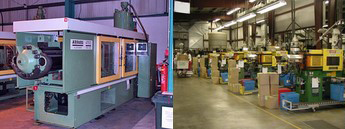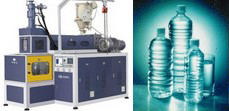Chillers for Plastics
Injection Molding Blow Molding Thermoforming Vacuforming

Glen Dimplex Thermal Solutions (GDTS) has provided plastic processing chillers to hundreds of customers for decades. Plastic molds and equipment rails are susceptible to sweating when the chilled water loop is too cold – resulting in spots or deformed parts. Koolant Koolers chillers will satisfy all of your requirements with reliable temperature stability so your product quality is not compromised.
Injection molding applications
For a large amount of injection molding jobs, cooling is approximately 90% of the cycle time. This means that while your application could be operating, it is in a cooling cycle until it can be functional again. The cooling stage starts at the end of the first stage of injection, while the rest of the molding cycle (pack, hold, cooling, mold open, and mold close) is cooling time. So if cooling is the greatest portion of time of the cycle, don’t overlook this critical aspect and lose an enormous percentage of profit as a result. Turn to Koolant Koolers for your cooling solutions.

| Rule of Thumb for Injection Molding Chiller Sizing | |
|---|---|
| 30# /HR of H.D. Polyethylene | = 1 Ton of cooling |
| 35# /HR of L.D. Polyethylene/ Polypropylene | = 1 Ton of cooling |
| 40# /HR of Nylon | = 1 Ton of cooling |
| 50# /HR of Polystyrene or ABS | = 1 Ton of cooling |
| 65# /HR of PVC or Polycarbonate | = 1 Ton of cooling |
| 70# /HR of P.E.T | = 1 Ton of cooling |
Koolant Koolers chillers can also be utilized to transfer heat out of the mold temperature controller (thermolator), the hydraulic heat exchanger, and the feed throat of injection molding machines.
There are two main reasons for using a chiller for the injection mold cooling process. To protect your equipment: while the chiller represents a small cost of the processing equipment, it provides solid protection of your investment, 24 hours a day, 7 days a week for years and years to come.

Secondly, to increase production. Maintaining a constant and proper cooling temperature in your process equipment will increase the number of parts produced per hour, and a significant reduction in the amount of defective parts.
Benefits of Using a Chiller System:
- Reduces Scrap Count: a consistent and reliable supply of the proper temperature to the process which means less scrap.
- Better Heat Transfer Rates, Less Maintenance and Downtime: because a chiller uses a closed water loop, a better quality of water will be used, resulting in better heat transfer rates, less required maintenance and decreased downtime.
- Colder Water: a chiller can produce much colder water (or water/glycol mixture) than any of the other cooling alternatives, giving you certain advantages under some circumstances.
Blow molding applications
Blow molding has long been the go-to process for producing plastic liquid containers. Koolant Koolers portable chillers, split systems, and closed loop chillers are just a few solutions for blow molding machines.
Rule of thumb for Blow Molding Chiller Sizing
40#/HR of Polyolefins = 1 Chiller Ton Cooling Required
Application Description:
The bottled beverage industry relies heavily on blow molding. Since the introduction of bottled water into the market in the 90’s, it has become a household norm. Blow molding a two-liter soda bottle requires a preformed piece called a parison. This parison is usually extruded from a plastic injection mold placed very close to the blow molding machinery. The warm parison looks like an upside-down plastic test tube, with an accurately molded collar and threads for the cap at the bottom. The parison is mechanically loaded onto a stand and two sides of a bottle-shaped metal mold come together around it.
Before the parison cools down, a hollow ramrod is injected into its center and pushed to the top of the mold, stretching out the warm plastic preform as it goes. Compressed air is then forced out in controlled low-pressure stages through the hollow ramrod. The plastic form is forced out to the sides of the mold. Because the stretching is performed evenly, the plastic remains uniformly thin and strong. The soda bottle assumes the shape of the mold and is dropped out of the blow molding machine as the two mold halves separate. A new parison is extruded and the entire blow molding process begins again. The actual manufacture of a soda bottle takes only a few seconds.

There are other forms of blow molding, but the general principle is the same. The plastic acts much like a latex rubber balloon — as long as the pressure from the compressed air is controlled, the material will expand uniformly and form the shape of the mold. This requires a fair amount of skill and experience on the part of the blow molding engineers who design new pieces of equipment.
Thermoforming applications
Glen Dimplex Thermal Solutions provides Koolant Koolers chillers to molding companies for solutions to cool their thermoforming machine molds. Modular chillers, portable chillers, closed loop chillers, are some of the solutions GDTS has for this industry.
Application Description:
Thermoforming is a manufacturing process where a plastic sheet is heated to a pliable forming temperature, formed to a specific shape in a mold, and trimmed to create a usable product. The sheet, or “film” when referring to thinner gauges and certain material types, is heated in an oven to a high-enough temperature that it can be stretched into or onto a mold and cooled to a finished shape.

In its simplest form, a small tabletop machine can be used to heat sections of plastic sheet and stretch it over a mold using vacuum. This method is often used for sample and prototype parts. In complex and high-volume applications, large production machines are utilized to heat and form the plastic sheet and trim the formed parts from the sheet in a continuous high-speed process. Automatic equipment can produce many thousands of finished parts per hour depending on the machine and mold size and the size of the parts being formed.
Thermoforming differs from injection molding, blow molding, rotational molding, and other forms of processing plastics. Thin-gauge thermoforming technology is primarily used for the manufacture of disposable cups, containers, lids, trays, blisters, clam shells, and other products for the food, medical, and general retail industries. Thick-gauge thermoforming includes parts as diverse as vehicle door and dash panels, refrigerator liners, utility vehicle beds, and plastic pallets.
Vacuforming applications
Koolant Koolers supplies vacuum forming process cooling units. Vacuum forming machines can be cooled using one central chiller unit, or each machine can be cooled using its own dedicated packaged chiller. Portable chillers can be utilized if a chiller will need to be moved from press to press throughout the shop regularly. Simple digital temperature controls are standard unless microprocessor is requested as option. We have standard Koolant Koolers chillers on the shelf. Contact us to discuss your application.
Application Description:
Vacuum forming, commonly known as “vacuforming”, is a simplified version of thermoforming, whereby a sheet of plastic is heated to a forming temperature, stretched onto or into a single-surface mold, and held against the mold by applying vacuum between the mold surface and the sheet. The vacuum forming process can be used to make most product packaging, speaker casings and even car dashboards.
Normally, draft angles must be present in the design on the mold (a recommended minimum of 3°), otherwise release of the formed plastic and the mold is very difficult.

Vacuum forming is usually – but not always – restricted to forming plastic parts that are rather shallow in depth. A thin sheet is formed into rigid cavities for unit doses of pharmaceuticals and for loose objects that are carded or presented as point-of-purchase items. Thick sheet is formed into permanent objects such as turnpike signs and protective covers. Relatively deep parts can be formed if the form-able sheet is mechanically or pneumatically stretched prior to bringing it in contact with the mold surface and before vacuum is applied.
Suitable materials for use in vacuum forming are conventionally thermoplastics, the most common and easiest being High Impact Polystyrene Sheeting (HIPS). This is molded around a wood, structural foam or cast/machined aluminum mold and can form to almost any shape. Vacuum forming is also appropriate for transparent materials such as acrylic which are widely used in applications for aerospace such as PCW (passenger cabin windows) canopies for military fixed wing aircraft and “bubbles” for rotary wing aircraft.
Cooling Load "rule of thumb" Sizing
To size your production machine cooling load use the following information: Calculate the total lbs/hour of material your machine uses and divide it by the lbs/ton listed below for your specific process. This will give you the tons of cooling required at 50° F exit water temperature. When operating below 50° F you must decrease the rated chiller cooling capacity by 2% for every one degree F you operate below 50° F.
| INJECTION MOLDING - 'x' LBS / TON | EXTRUSION - 'x' LBS / TON |
| 30 lbs/hour HDPE 35 lbs/hour LDPE 35 lbs/hour Acrylic 35 lbs/hour PP 40 lbs/hour Nylon 40 lbs/hour Derlin 40 lbs/hour Urethane 45 lbs/hour PET 50 lbs/hour PS 50 lbs/hour ABS 50 lbs/hour PC 50 lbs/hour Acetal 70 lbs/hour PVC |
SHEET CALENDERING 35 lbs/hour PE 60 lbs/hour ABS 60 lbs/hour PS PROFILE 50 – 60 lbs/hour HDPE 50 – 60 lbs/hour LDPE 50 – 60 lbs/hour PP 50 – 60 lbs/hour PET 60 – 75 lbs/hour ABS 60 – 75 lbs/hour PVC |
| FEED THROAT: 1/2 ton up to 400 ton injection. 1 ton over 400 ton injection. |
Barrel - 1 ton/” screw dia Screw - 2 tons Throat - 1/2 ton up to 3″ Throat - 1 ton 4″ to 6″ Gear drive - 100 hp/ton |
| BLOW MOLDING - 'x' / TON | VACUUM FORMING - 'x' / TON |
| 40 lbs/hour HDPE 40 lbs/hour PET 40 lbs/hour PVC |
70 lbs/hour HDPE & LDPE 70 lbs/hour PP 200 lbs/hour PS 250 lbs/hour PVC |
| HOT RUNNER MOLDS convert heater watts to Btu's and divide by 2 (watts x 3.414 divide by 24,000 Btu’s) MOTOR COOLING LOAD FOR PORTABLE CHILLERS | |
| Hydraulic cooling: | 8 hp - 1 ton |
| Vacuum pumps: | 8 hp - 1 ton |
| Air compressors: | 8 hp - 1 ton (internal oil cooling). |
| 8 hp - 1 ton (after cooler cooling). | |
| Chilled water flow rate is 2.4 gpm ton. | |
| Chiller ton is 12,000 Btu’s | |
| Chiller operating temperature range with water is from 45° F. to 60° F. exit water temperature. | |
| Chiller operating temperature range with glycol/water is from 25° F. to 45° F. exit water temperature. | |







